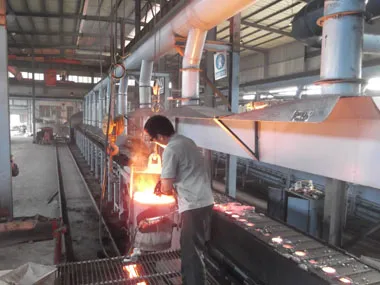Mobile:+86-311-808-126-83
Email:info@ydcastings.com
aluminum casting
The Versatility of Aluminum Casting in Modern Manufacturing
Aluminum casting has emerged as a cornerstone of modern manufacturing, showcasing unparalleled versatility and the ability to meet diverse industry needs. As industries evolve, the demand for lightweight, durable materials has driven the growth of aluminum casting techniques, which offer a range of benefits from cost-effectiveness to remarkable mechanical properties.
Aluminum is a metal known for its lightweight nature, excellent corrosion resistance, and high strength-to-weight ratio. These attributes make it an ideal candidate for casting in numerous applications, including automotive, aerospace, electronics, and consumer goods. The melting point of aluminum is relatively low (approximately 660 degrees Celsius), which makes it easier to cast compared to other metals, allowing for energy-efficient production processes.
The aluminum casting process involves several methods, each suited to specific applications and requirements. The most common techniques include sand casting, die casting, and investment casting.
1. Sand Casting This method involves creating a mold from sand, which is then used to form the aluminum object. It is particularly cost-effective for low-volume production and allows for the creation of complex shapes. Sand casting is widely used in automotive parts, engine blocks, and other large components due to its flexibility and ability to handle various aluminum grades.
2. Die Casting This technique uses high-pressure to inject molten aluminum into a mold cavity. Die casting is favored for mass production as it produces precise and consistently high-quality parts with minimal finishing required. The process is ideal for manufacturing intricate shapes with smooth surfaces, making it well-suited for appliances, automotive components, and consumer electronics.
aluminum casting

3. Investment Casting Also known as lost-wax casting, this method involves creating a wax pattern that is coated in a refractory material. Once the coating hardens, the wax is melted away, leaving a mold that is filled with molten aluminum. This technique is perfect for producing complex geometries and achieving tight tolerances, making it an excellent choice for aerospace and medical applications.
One of the significant advantages of aluminum casting is its recyclability. Approximately 75% of aluminum ever produced is still in use today, thanks in large part to its ability to be recycled without loss of quality. This environmental benefit resonates with modern manufacturing philosophies that prioritize sustainability. By using recycled aluminum in casting processes, manufacturers can significantly reduce energy consumption and carbon emissions.
In terms of mechanical properties, aluminum castings exhibit excellent strength and ductility, making them suitable for a wide range of applications. The addition of alloying elements such as silicon, copper, and magnesium can modify the material properties to meet specific requirements. For instance, aluminum-silicon cast alloys are known for their fluidity and corrosion resistance, ideal for automotive and marine applications.
The future of aluminum casting is bright, driven by advances in technology and manufacturing processes. Innovations such as 3D printing are beginning to complement traditional casting methods, offering new opportunities for customization and rapid prototyping. This integration of technologies enables manufacturers to produce lightweight components with complex geometries that were previously unattainable.
Moreover, the growing emphasis on electric vehicles (EVs) and renewable energy solutions has spurred further interest in aluminum casting. The automotive industry, in particular, is increasingly relying on aluminum components to enhance fuel efficiency and reduce overall vehicle weight. As such, aluminum castings will continue to play a pivotal role in supporting the transition to more sustainable transportation solutions.
In conclusion, aluminum casting stands out as a vital manufacturing process that balances performance, efficiency, and sustainability. With its wide range of casting methods and the inherent advantages of aluminum as a material, this technology will continue to evolve, meeting the demands of various industries and contributing to a greener, more sustainable future. As manufacturers embrace innovation and explore new applications for aluminum casting, the industry's potential for growth and advancement remains limitless.
-
Why Should You Invest in Superior Pump Castings for Your Equipment?NewsJun.09,2025
-
Unlock Performance Potential with Stainless Impellers and Aluminum End CapsNewsJun.09,2025
-
Revolutionize Your Machinery with Superior Cast Iron and Aluminum ComponentsNewsJun.09,2025
-
Revolutionize Fluid Dynamics with Premium Pump ComponentsNewsJun.09,2025
-
Optimizing Industrial Systems with Essential Valve ComponentsNewsJun.09,2025
-
Elevate Grid Efficiency with High-Precision Power CastingsNewsJun.09,2025











